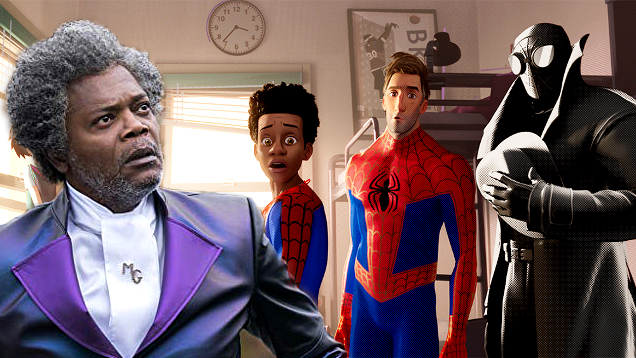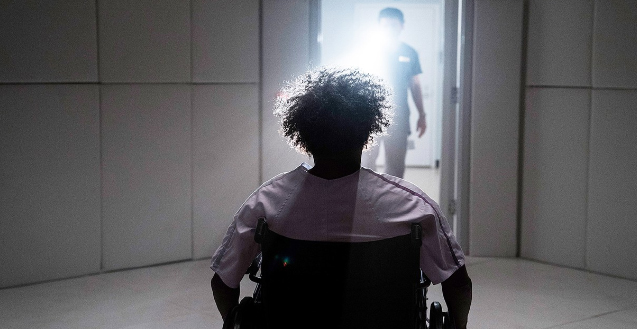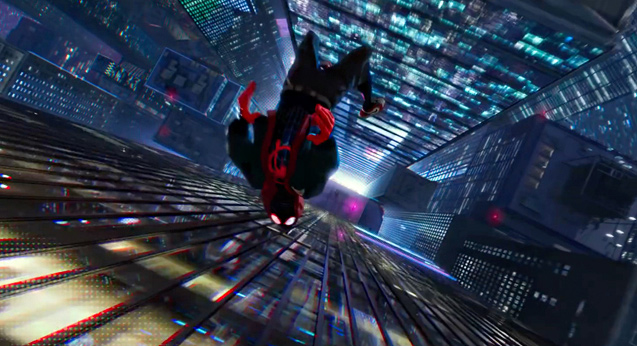Huzzah! Two thrilling and intensely thoughtful superhero movies are now playing in cinemas

It’s not every week, every month or even every year that two super smart superhero movies play in cinemas at the same time. Critic Luke Buckmaster worships at the altar of Glass and Spider-Man: Into the Spider-Verse.
The current moment is a rare point in time for multiplex movies. Cinemas are now exhibiting two fiercely intelligent, wildly entertaining, outside-the-box superhero films that rejuvenate moth-eaten narratives with fresh perspectives. One is rare, let alone a pair. These audacious productions kick meta ideas around about comic book mythology informing the very fabric of reality. They are weird and they are thrilling. And no, neither of them is Aquaman.
M. Night Shyamalan’s mind-bender Glass brings together characters from his finest film – 2000’s Unbreakable – and his 2011 popcorn thriller Split. The erratic writer/director counters the sheer unrelatability of superheroes and supervillains (we know, going into these films, that we will never have their abilities nor look as good in nipple-emphasising spandex) by connecting the perception of super powers with the possibility of mental illness. That connection was made explicitly (and with Seinfeldian vengeance) in James Gunn’s rambunctiously entertaining action-comedy Super.
The three lead characters in Glass – David Dunn (Bruce Willis), Elijah Price (Samuel L. Jackson) and the multiple personality disorder-afflicted Kevin (James McAvoy) – spend the vast majority of the running time in a mental institution. A psychiatrist (Sarah Paulson) attempts to dissuade them of the special powers we know they have, presenting evidence that they are flesh and blood mortals like everybody else. This is Shyamalan wading in on political and scientific discourse in the era of fake news. For everything people believe in a counter argument exists, he says, no matter how wrong or preposterous.

Instead of whooshing the audience through vertiginous set pieces and stupefying them with CGI, Shyamalan redefines the architecture of the superhero story. The main attractions aren’t smotherings of spectacle but characters and concepts. The actors are the equivalent of special effects; the dialogue exchanges are the set pieces.
Glass’ rare quality as a superhero movie that truly values the craft of acting is most clearly evident in the gradual reveal of Elijah (his actions, his thoughts, his words) and Samuel J. Jackson’s slow-to-erupt performance. For a long time the mastermind bad guy stays silent and poker-faced; we wait and wait and wait for him to serenade us with badassery.
Glass is also a superhero movie with a rare kind of credibility. It doesn’t want viewers to zone out during the action scenes; it doesn’t want them to buy toys or download the video game or eat the affiliated Happy Meal. It wants viewers to pay attention. The one thing this fine film values more than encouraging thought from the audience is being thoughtful itself. How many franchise superhero movies can you say the same of?
Spider-Man: Into the Spider-Verse is also intensely thoughtful, in a bam-bam-bam, pow-pow-pow, whiplash-inducing way that affords the audience little time for contemplation; little time to think about its thoughtfulness. It’s like a roller coaster ride: once you’re on it, you have no choice but to feel a bone-rattling rush, and the artistry of the experience is comprehended later if at all.
Spider-Verse is also visually interesting, like Glass, but again for quite different reasons. While Glass’ cinematographer Mike Gioulakis shows flair for creative compositions and holding the frame, the directors (Bob Persichetti, Peter Ramsey and Rodney Rothman) of Spider-Verse don’t so much ‘hold’ the frame as smash it into tiny pieces, then shower the audience in its bling-slathered shards. Glass‘ compositions leak oxygen; Spider-Verse‘s are vacuum-sealed and pressure-packed.

The sparkling surfaces of Spider-Verse look great. But the way the film considers disparities in its own aesthetic – conjuring ideas around perception of reality versus design of it – are more exciting. A magical portal not just brings into the same world different iterations of the web-slinging titular hero, but different visual styles accompanying them. Peni Parker, a girl who commands a gigantic spider robot called SP//dr, infuses her portions of the frame with a Manga look, while Spider-Pig evokes Looney Tunes animation. Infinite styles for infinite stories.
Don’t expect stylistically and philosophically interesting superhero movies to catch on; at least, not ones as interesting as these. The reign of the idiotic blockbuster Aquaman has reminded the studios of the financial benefits in engineering homogenized styles intended to fit all taste buds, while wholly satisfying few people if any – like a McDonald’s cheeseburger. The next superhero blockbuster on the horizon, Captain Marvel, certainly looks like more of the same-old.
But Glass and Into the Spider-Verse: these are superhero movies for the ages. A long time after the vast majority of movies in this crowded genre have blended together in our minds and faded into the public consciousness, these ones will be remembered. The legacy of both films – Shyamalan’s especially – is to remind us that it is to better to make art that is bold, thoughtful and a little off-balance than to make art that is safe, formulaic and even-handed.
















